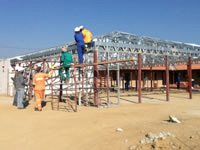 Build green, build fast
Build green, build fast
Sustainable building practices are proving their worth in the infrastructure construction sector
The Olievenhoutbosch project currently underway in Gauteng is turning heads at the Gauteng Department of Education, not only for the fact that the new school is being constructed with the use of alternative building materials but also because the project is delivering a completed school well within the allotted time frame.
A spokesperson for the Department of Education indicates to Construction Review that both of these aspects address two major issues in the construction of new schools in the country at the moment.
“We have an infrastructure programme in place but you will often see that the projects fall apart during the planning phases,” he starts.
The first problem is the cost of conventional brick and mortar facilities with contractors often being accused of cutting corners when tendering for a project. The second issue is timing.
The average time allowed by the Department for the construction of a school is 36 months and it need to be noted that at present, many contractors fall short of this deadline when relying on brick and mortar construction.
Alternative approach required
Contractor, Transgariep Infra’s (TGI) tender included the use of light steel framing, complemented by the use of a concrete and polystyrene mix and the method of construction was relatively uncomplicated.
Assembling the light steel frame of the building, the construction crew then erected hollow panelling and filled the cavity in between with a mix of cement and expanded polystyrene balls. The components for the concrete are mixed on site and pumped into the cavities.
TGI’s Danie Kruger points out that the system also requires few skilled workers on site. “We are able to create work in the local community because the system requires that we have a only a few experienced workers on site to supervise.
They train the other workers on site in a short period of time and the project can commence,” he says. Kruger adds that the alternative construction method also has very few challenges. “Our only obstacle was the bulk earthworks on site since we had to deal with boulders and water but after that, construction went smooth,” he says.
The company is handing over the site in this month; a mere six months after construction began.
Kruger adds that in addition to being at least 40% cheaper and significantly faster than conventional methods, the polystyrene in the cement mix also acts as insulation in the buildings, significantly reducing cooling and heating costs in future.
The system
The steel framing and concrete system has been entirely devised by the Razorbill Group, which consists of four divisions that jointly supply the products and services employed on this site.
The company has put a significant amount of emphasis on producing buildings that are safe comfortable and which have insulation values that are more than double that achieved with conventional building techniques. With the ongoing focus on Green Star rated building in South Africa, waste generation is also limited and contained within the manufacturing plant were components are produced. All waste generated during the manufacturing process is recycled thereby reducing the environmental foot print of the system even further.
Transport requirements for delivery of materials to the construction site is reduced significantly due to the products used being less than a third the mass of that consumed in traditional building methods.
Thandi Moyo director and shareholder at Razorbill adds to Kruger’s earlier point. “Job creation and employee development is a key requirement for all systems used within our company and as such the systems invested in was chosen on a basis that it had to be basic enough to utilise local unskilled labour to execute projects yet sophisticated enough to meet the requirements of the current environmental and market climate.
It also needs to cater for the development criteria whereby it can create an environment which is conducive of developing people employed on projects to progress through the different levels within the company to eventually become managers, directors and partners in the existing business and planned business expansions,” he says.
With this in mind the company prescribed an already existing system to TGI which is used globally for the construction of single and multi storey buildings for residential, light commercial and institutional use. What struck one about this particular system was the fact that while the buildings are constructed of prefabricated components, the system’s flexibility rivals conventional building systems.
Package supplied
Included in Razorbill’s package to TGI was the training and utilization of members of the local community and maximum utilization of sub-contractors from the area. These initiatives resulted in the utilization of 45 members as well as 9 sub-contractors from the surrounding area.
The Razorbill Group of companies are currently involved in several infra-structure projects in South Africa and is finalizing a major contract for a turnkey project in sub-Saharan Africa which will utilize the same building methods.
TGI has also decided to take its partnership with the Razorbill further and has already been awarded the tender for another school project in South Africa.
Upon completion the school will also have functioning sports field and sustainable vegetable garden. While the alternative building approach has yet to take off in a big way in infrastructure development, it is interesting to note that the trend is beginning to grow, with another supplier of prefabricated building systems currently providing support for another school building in the province.
The green building industry seems to have its foot in the door of a traditionally stubborn industry.